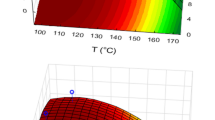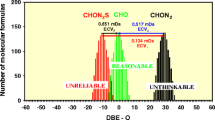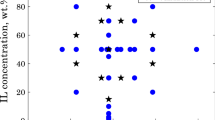Abstract
Absolute concentrations of total macromolecules (triglycerides, proteins and carbohydrates) in microorganisms can be rapidly measured by FTIR spectroscopy, but caution is needed to avoid non-specific experimental bias. Here, we assess the limits within which this approach can be used on model solutions of macromolecules of interest. We used the Bruker HTSXT-FTIR system. Our results show that the solid deposits obtained after the sampling procedure present physical and chemical properties that influence the quality of the absolute concentration prediction models (univariate and multivariate). The accuracy of the models was degraded by a factor of 2 or 3 outside the recommended concentration interval of 0.5–35 µg spot−1. Change occurred notably in the sample hydrogen bond network, which could, however, be controlled using an internal probe (pseudohalide anion). We also demonstrate that for aqueous solutions, accurate prediction of total carbohydrate quantities (in glucose equivalent) could not be made unless a constant amount of protein was added to the model solution (BSA). The results of the prediction model for more complex solutions, here with two components: glucose and BSA, were very encouraging, suggesting that this FTIR approach could be used as a rapid quantification method for mixtures of molecules of interest, provided the limits of use of the HTSXT-FTIR method are precisely known and respected. This last finding opens the way to direct quantification of total molecules of interest in more complex matrices.






Similar content being viewed by others
Abbreviations
- ATR:
-
Attenuated total reflectance
- FTIR:
-
Fourier-transform infrared spectroscopy
- HTSXT:
-
High-throughput screening extension
- PLS-R:
-
Partial least square regression
- PCA:
-
Principal component analysis
- CA:
-
Correspondence analysis
- HCPC:
-
Hierarchical clustering on principal components
- HCCA:
-
Hierarchical clustering on correspondence analysis
References
Yu C, Irudayaraj J (2005) Spectroscopic characterization of microorganisms by Fourier transform infrared microspectroscopy. Biopolymers 77(6):368–377
Winder CL et al (2011) Metabolic fingerprinting as a tool to monitor whole-cell biotransformations. Anal Bioanal Chem 399(1):387–401
Stehfest K, Toepel J, Wilhelm C (2005) The application of micro-FTIR spectroscopy to analyze nutrient stress-related changes in biomass composition of phytoplankton algae. Plant Physiol Biochem 43(7):717–726
Alvarez-Ordonez A et al (2011) Fourier transform infrared spectroscopy as a tool to characterize molecular composition and stress response in foodborne pathogenic bacteria. J Microbiol Methods 84(3):369–378
Mecozzi M, Pietroletti M, Tornambe A (2011) Molecular and structural characteristics in toxic algae cultures of Ostreopsis ovata and Ostreopsis spp. evidenced by FTIR and FTNIR spectroscopy. Spectrochim Acta A Mol Biomol Spectrosc 78(5):1572–1580
Courant F, Martzolff A, Rabin G, Antignac J-P, Bizec B, Giraudeau P, Tea I, Akoka S, Couzinet A, Cogne G, Grizeau D, Gonçalves O (2013) How metabolomics can contribute to bio-processes: a proof of concept study for biomarkers discovery in the context of nitrogen-starved microalgae grown in photobioreactors. Metabolomics 9(6):1286–1300
Wrolstad RE, Decker EA, Schwartz SJ, Sporns P (eds) (2005) Handbook of food analytical chemistry: water, proteins, enzymes, lipids, and carbohydrates. Wiley-Blackwell, New Jersey an imprint of John Wiley & Sons Ltd
Wu H, Volponi JV, Oliver AE, Parikh AN, Simmons BA, Singh S (2011) In vivo lipidomics using single-cell Raman spectroscopy. Proc Natl Acad Sci USA 108(9):3809–3814
Wagner H, Liu Z, Langner U, Stehfest K, Wilhelm C (2010) The use of FTIR spectroscopy to assess quantitative changes in the biochemical composition of microalgae. J Biophotonics 3(8–9):557–566
Stevenson HJ, Levine S (1952) Infrared spectra of pneumococcal polysaccharides. Science 116(3026):705–706
Dean AP, Sigee DC, Estrada B, Pittman JK (2010) Using FTIR spectroscopy for rapid determination of lipid accumulation in response to nitrogen limitation in freshwater microalgae. Bioresour Technol 101(12):4499-4507
Pistorius AM, DeGrip WJ, Egorova-Zachernyuk TA (2009) Monitoring of biomass composition from microbiological sources by means of FT-IR spectroscopy. Biotechnol Bioeng 103(1):123–129
Berthomieu C, Hienerwadel R (2009) Fourier transform infrared (FTIR) spectroscopy. Photosynth Res 101(2–3):157–170
Cakmak T, Angun P, Demiray YE, Ozkan AD, Elibol Z, Tekinay T (2012) Differential effects of nitrogen and sulfur deprivation on growth and biodiesel feedstock production of Chlamydomonas reinhardtii. Biotechnol Bioeng 109(8):1947–1957
Mie G (1908) Contributions on the optics of turbid media, particularly colloidal metal solutions. Ann Phys (Leipzig) 25:377–452
Davis R, Mauer LJ (2010) Fourier transform infrared (FT-IR) spectroscopy: a rapid tool for detection and analysis of foodborne pathogenic bacteria. Formatex Research Center, vol 2, no. 1, pp 1582–1594
Romeo M, Mohlenhoff B, Diem M (2006) Infrared micro-spectroscopy of human cells: causes for the spectral variance of oral mucosa (buccal) cells. Vib Spectrosc 42(1):9–14
Husson F, Josse J, Lê S (2008) FactoMineR: a R package for multivariate analysis. J Stat Softw 25(1):1–18
Lee H, Choi JH, Cho M (2010) Vibrational solvatochromism and electrochromism of cyanide, thiocyanate, and azide anions in water. Phys Chem Chem Phys 12(39):12658–12669
Stafford AJ, Walker DM, Webb LJ (2012) Electrostatic effects of mutations of Ras glutamine 61 measured using vibrational spectroscopy of a thiocyanate probe. Biochemistry 51(13):2757–2767
Iñón FA, Garrigues JM, Garrigues S, Molina A, de la Guardia M (2003) Selection of calibration set samples in determination of olive oil acidity by partial least squares—attenuated total reflectance—Fourier transform infrared spectroscopy. Anal Chim Acta 489(1):59–75
Horton RB et al (2011) Fourier transform infrared (FT-IR) spectroscopy and improved principal component regression (PCR) for quantification of solid analytes in microalgae and bacteria. Appl Spectrosc 65(4):442–453
ASTM Committee E13 on Molecular Spectroscopy and Chromatography (2005) Standard practices for infrared multivariate quantitative analysis E 1655-05, pp 1–29
Acknowledgments
Part of this work was funded by the French National Research Agency project DIESALG (ANR-12-BIME-0001). The authors thank undergraduate student Véronique Airiau for her preliminary work performed on ATR-FTIR.
Author information
Authors and Affiliations
Corresponding author
Additional information
E. Serrano León and R. Coat contributed equally to this work.
Electronic supplementary material
Below is the link to the electronic supplementary material.
449_2014_1215_MOESM1_ESM.pdf
Fig. S1. Microscopic observations of the spots formed after drying the deposits of solutions of model molecules. Frist line corresponds to three amounts of BSA, second line to three amounts of tripalmitate, third line to three amounts of glucose, and fourth line to three amounts of the mixture of glucose plus BSA (20 µg). (PDF 2758 kb)
449_2014_1215_MOESM2_ESM.pdf
Fig. S2. FTIR raw spectra shape variation observed according to the amount of deposited quantity of matter. Left panel corresponds to several amounts of BSA mixed with 1 µg of KSCN (internal standard), right panel to the glucose mixed with 1 µg of KSCN (internal standard) and 20 µg of BSA (stabilizer). The amounts of deposited matter are indicated on each panel on the spectra, and range from 1 µg to 150 µg of tested compound. On the x axis are wave numbers (cm−1) and on the y axis absorbance values. (PDF 285 kb)
449_2014_1215_MOESM3_ESM.xls
Table S1. Characteristics of the linear models obtained for the determination of the limit of linearity of the FTIR analytical approach according to the different rupture points. The points surrounding the strong shifts observed in the solvatochromic study were also taken into account, i.e., 0.5, 30, 35, 40, 95, 100, 150 µg.spot−1. The reference data obtained in [9] are also indicated. (XLS 35 kb)
449_2014_1215_MOESM4_ESM.xls
Table S2. Quality parameters for cross and test set validation of the PLS-R selected for the quantitative prediction of the model macromolecules. RMSECV stands for root mean square error of cross-validation. RMSEP stands for root mean square error of prediction. R² is the coefficient of determination (predicted vs. actual concentration in the calibration (CV) or validation set (EP)). Rank corresponds to the number of latent factors in the selected PLS-R model (calibration (CV) or validation set (EP)). The models were generated in the range 1,900–950 cm−1. The median and average values of the statistical parameters are indicated at the bottom of the table. (XLS 34 kb)
449_2014_1215_MOESM5_ESM.xls
Table S3. Quality parameters for cross and test set validation of the PLS-R selected for the quantitative prediction of a mixture of model macromolecules. BSA (BSA + Glc) refers to the specific prediction of BSA amount in the mixture of glucose + BSA. Glc (BSA + Glc) refers to the specific prediction of glucose amount in the mixture of glucose + BSA. RMSECV stands for root mean square error of cross-validation. RMSEP stands for root mean square error of prediction. R² is the coefficient of determination (predicted vs. actual concentration in the calibration (CV) or validation set (EP)). Rank corresponds to the number of latent factors in the selected PLS-R model (calibration (CV) or validation set (EP)). The models were generated in the range 1,900–950 cm−1. The median and average values of the statistical parameters are indicated at the bottom of the table. (XLS 28 kb)
Rights and permissions
About this article
Cite this article
Serrano León, E., Coat, R., Moutel, B. et al. Influence of physical and chemical properties of HTSXT-FTIR samples on the quality of prediction models developed to determine absolute concentrations of total proteins, carbohydrates and triglycerides: a preliminary study on the determination of their absolute concentrations in fresh microalgal biomass. Bioprocess Biosyst Eng 37, 2371–2380 (2014). https://doi.org/10.1007/s00449-014-1215-4
Received:
Accepted:
Published:
Issue Date:
DOI: https://doi.org/10.1007/s00449-014-1215-4




